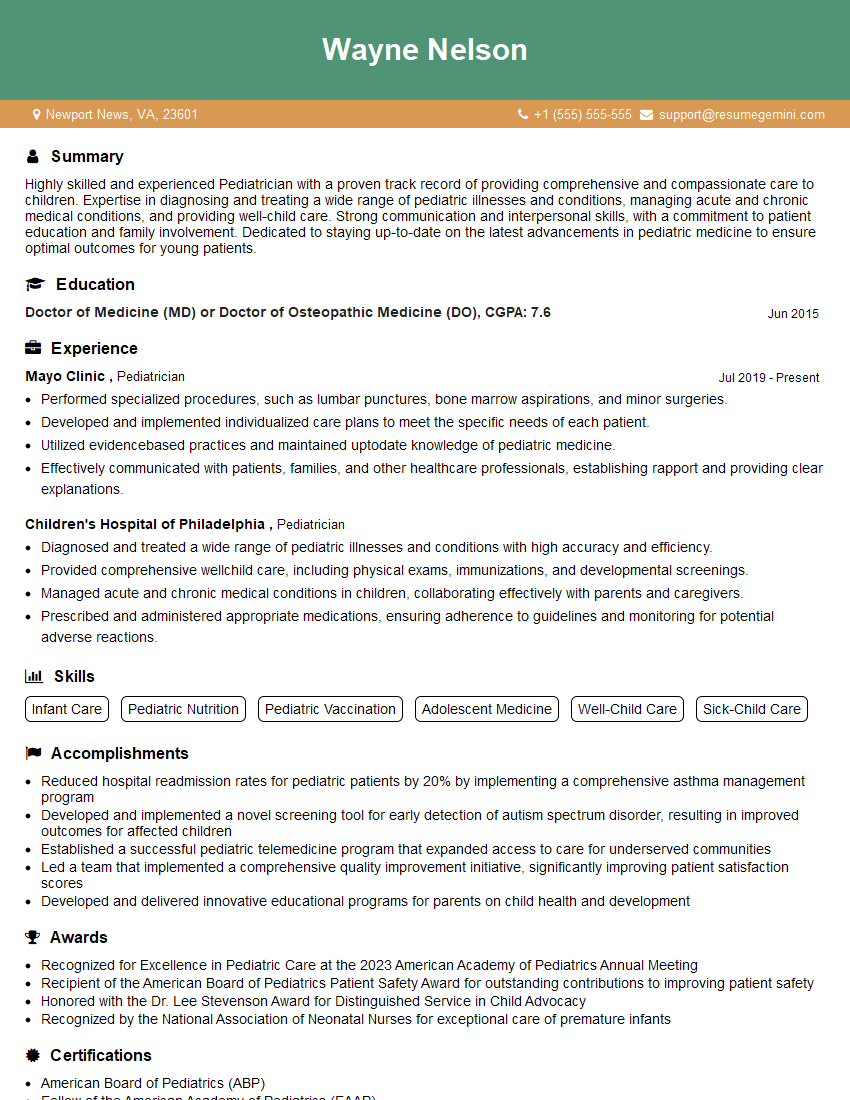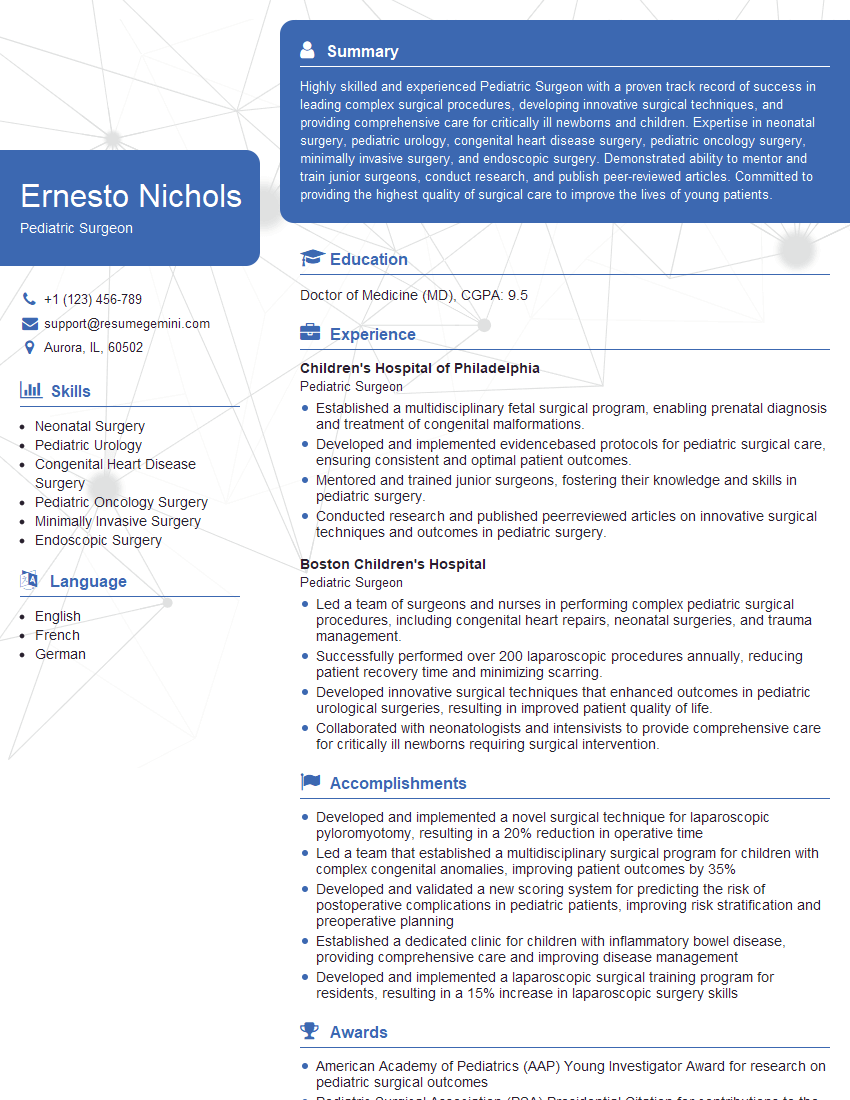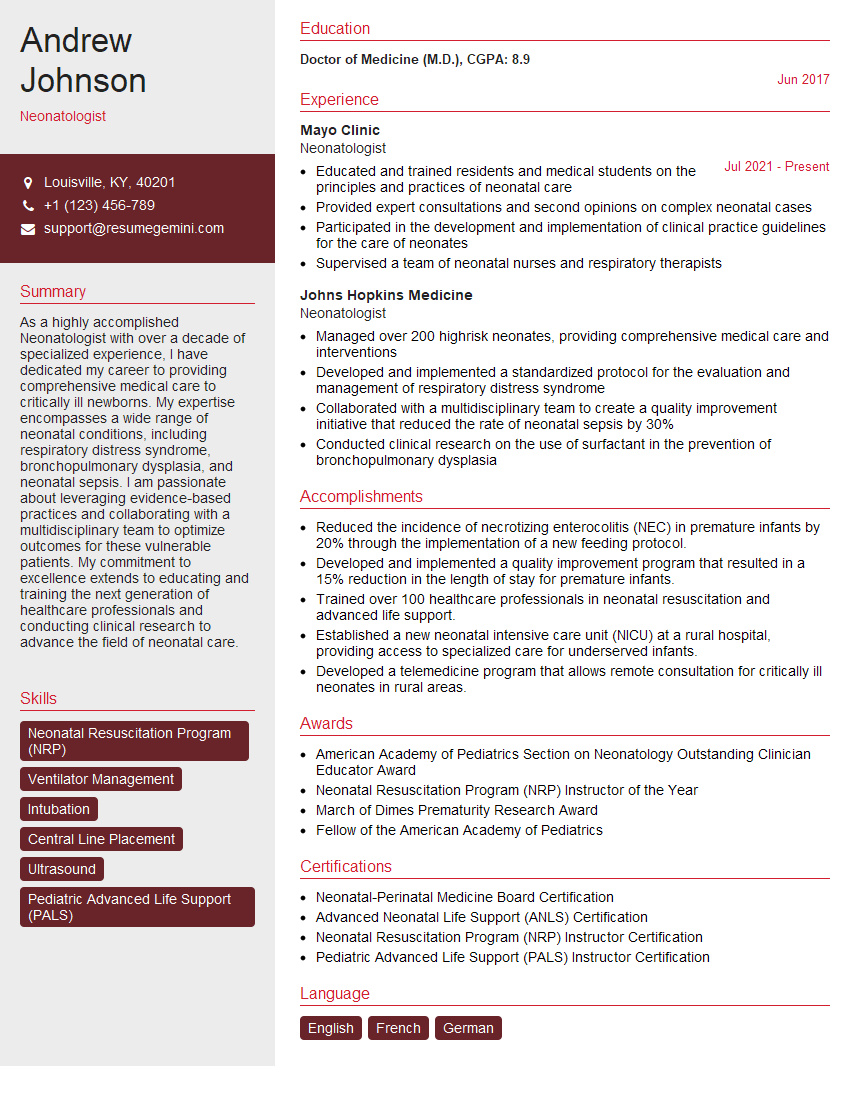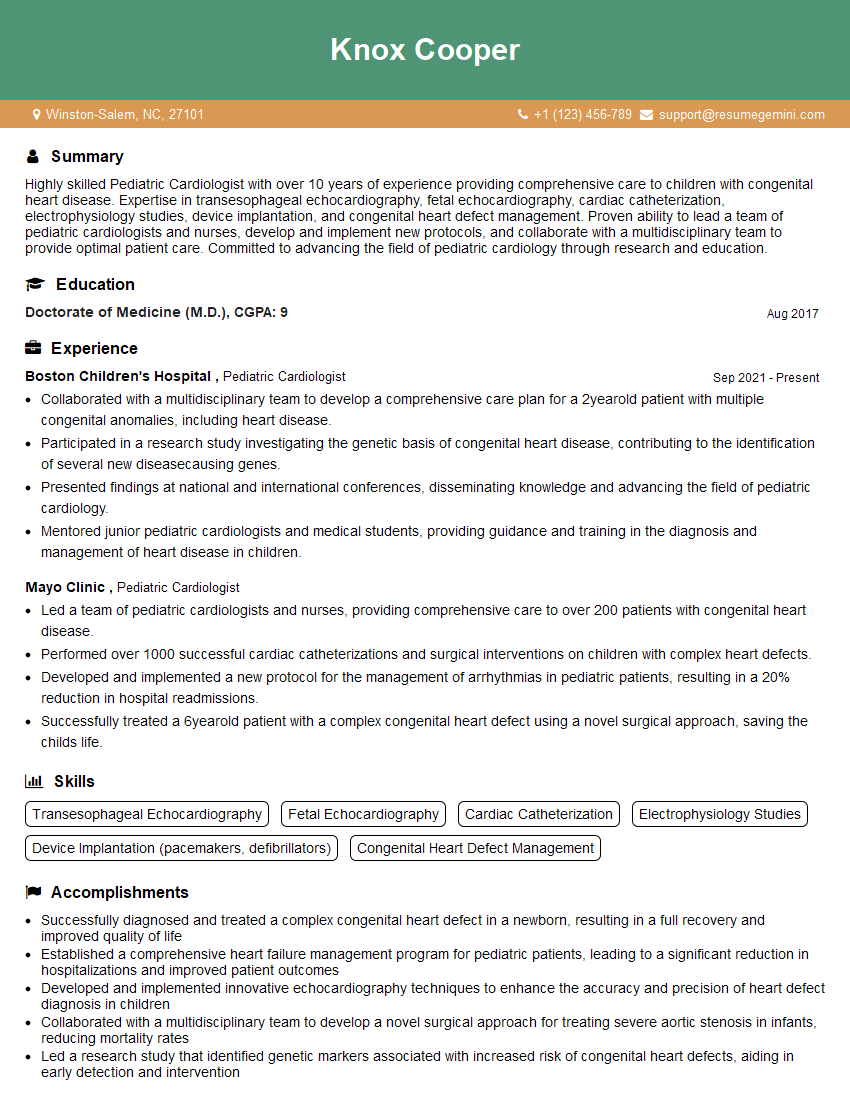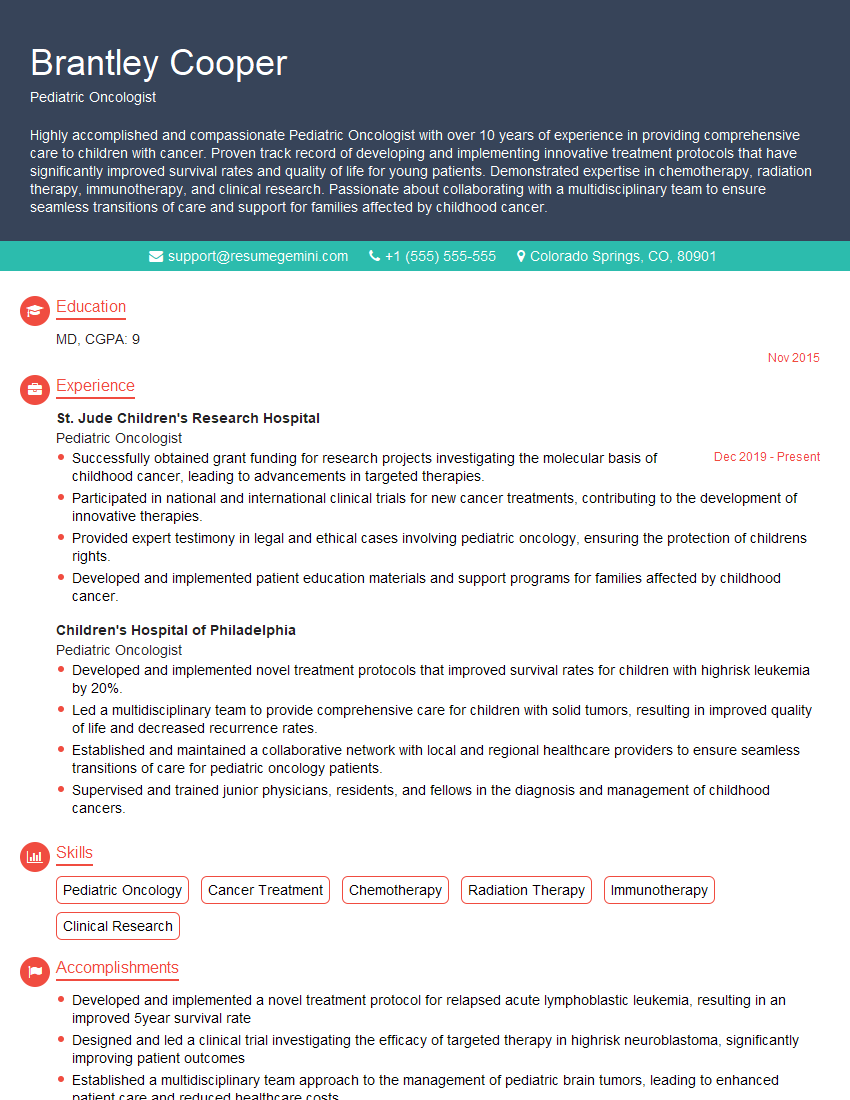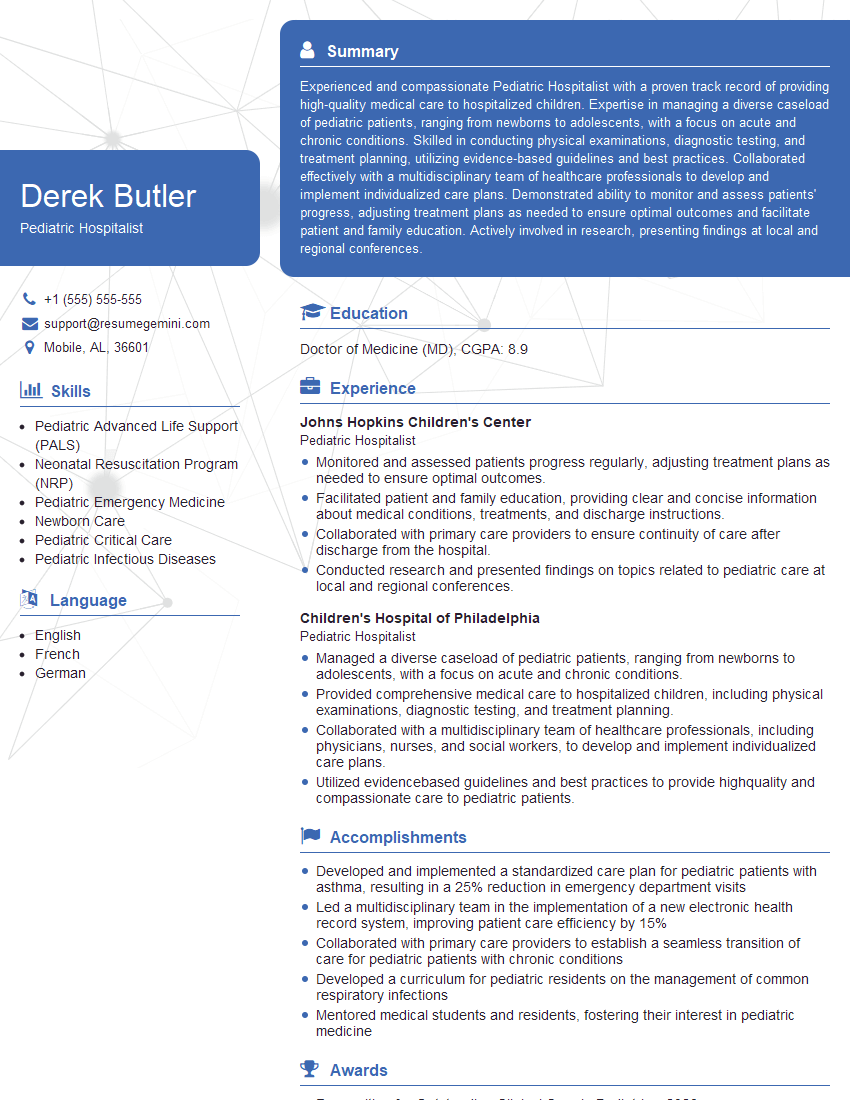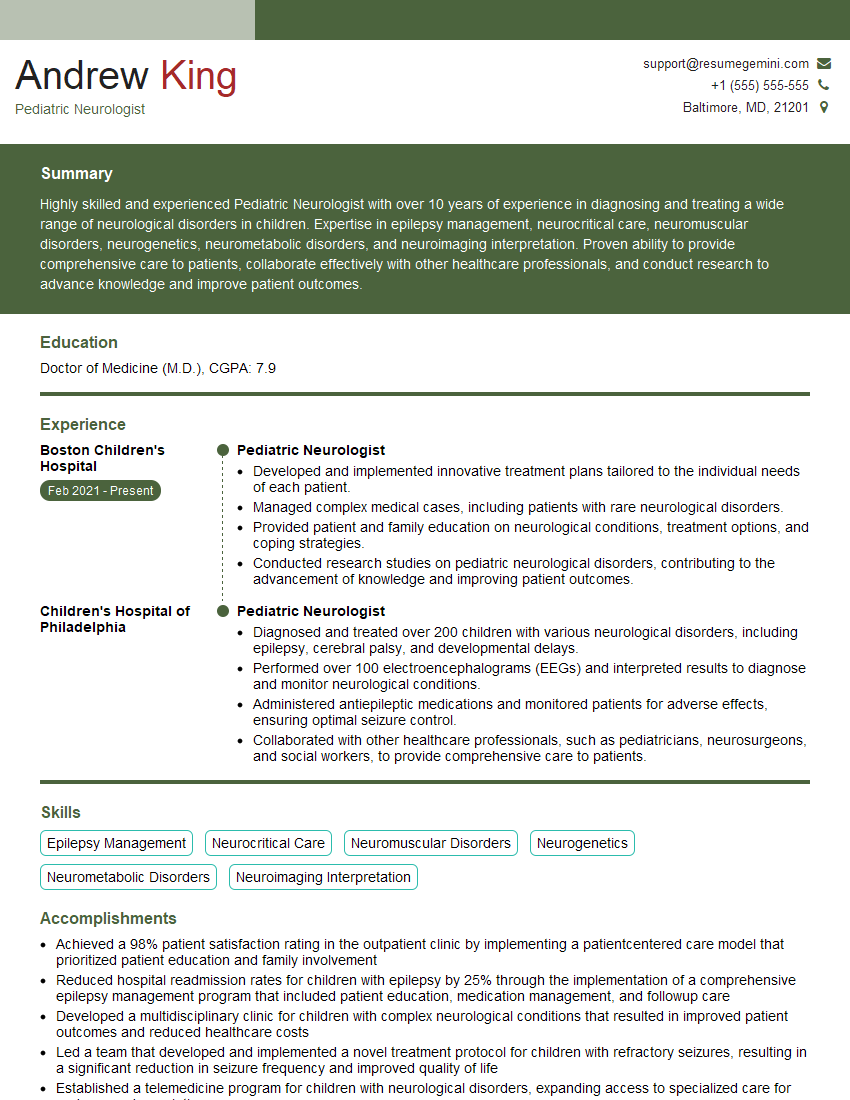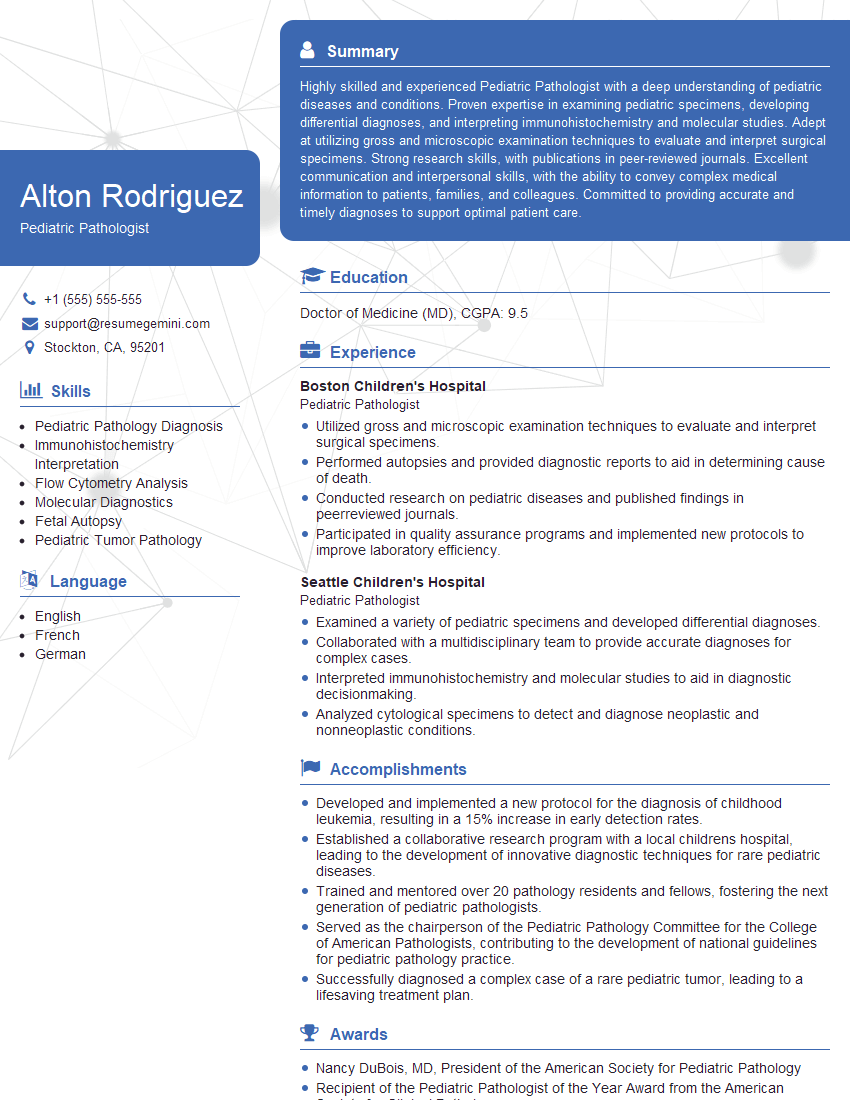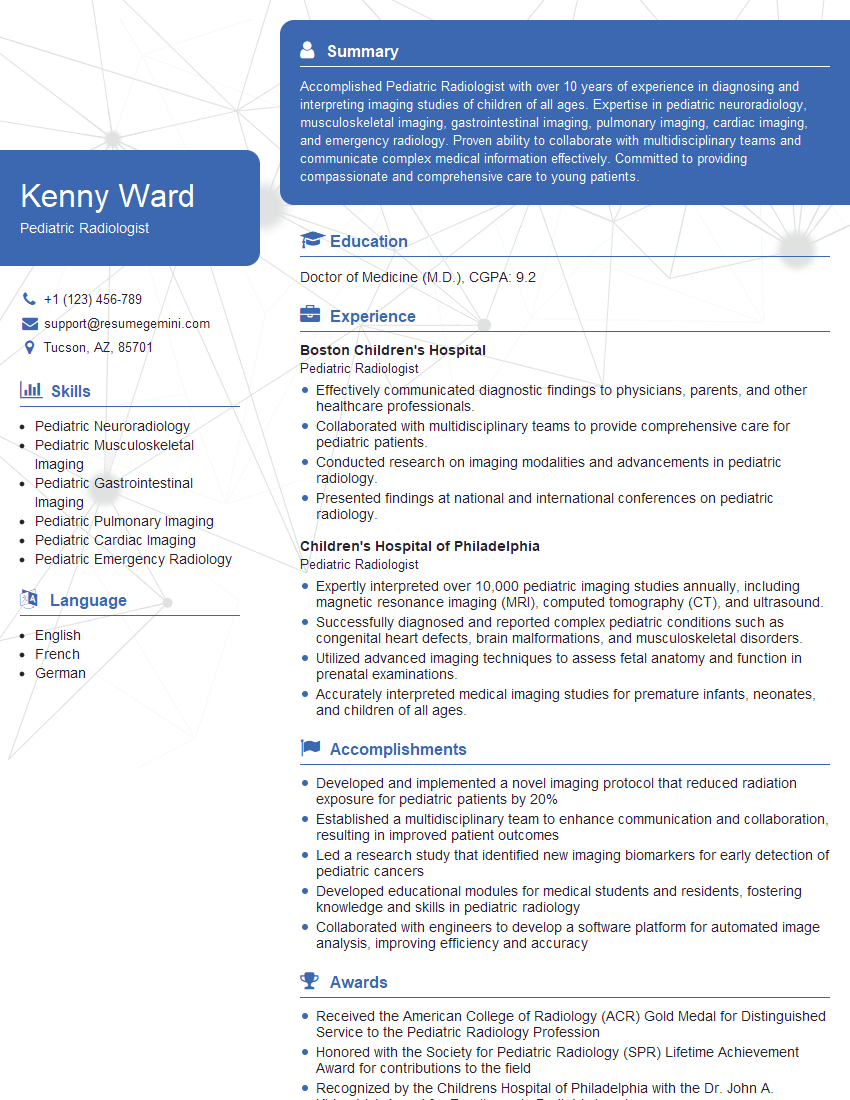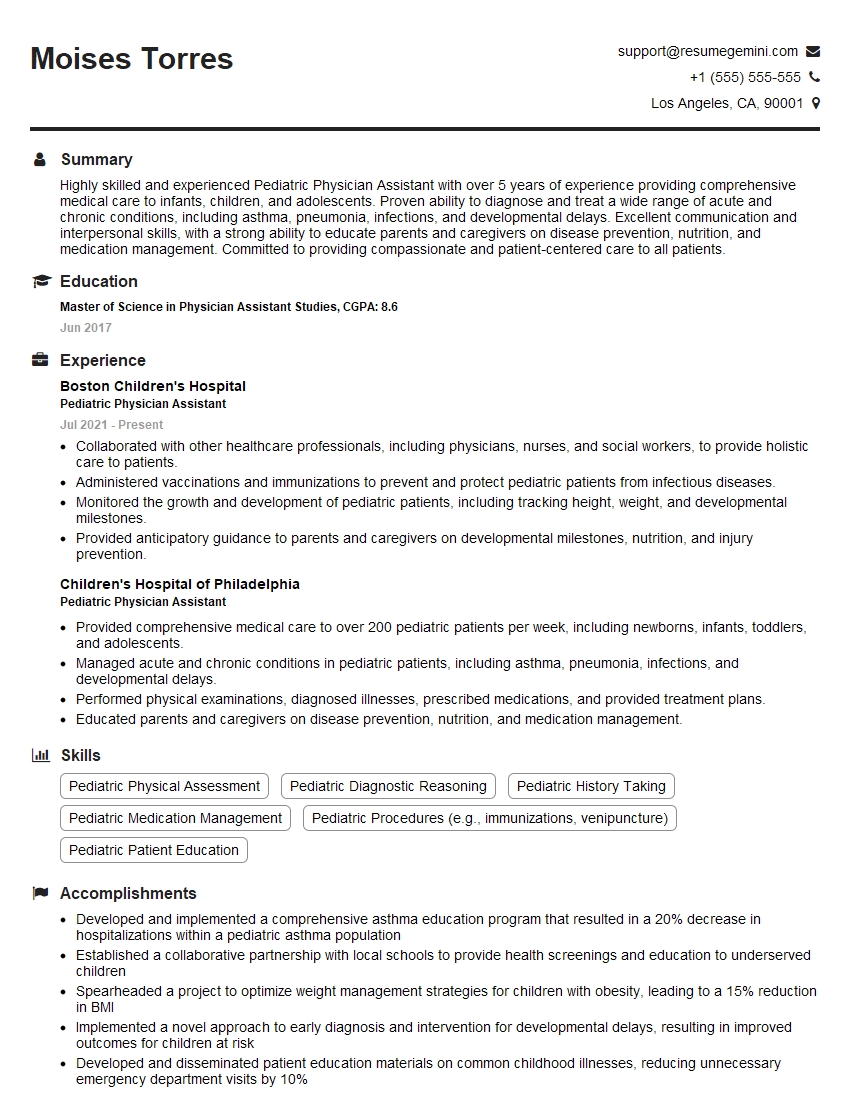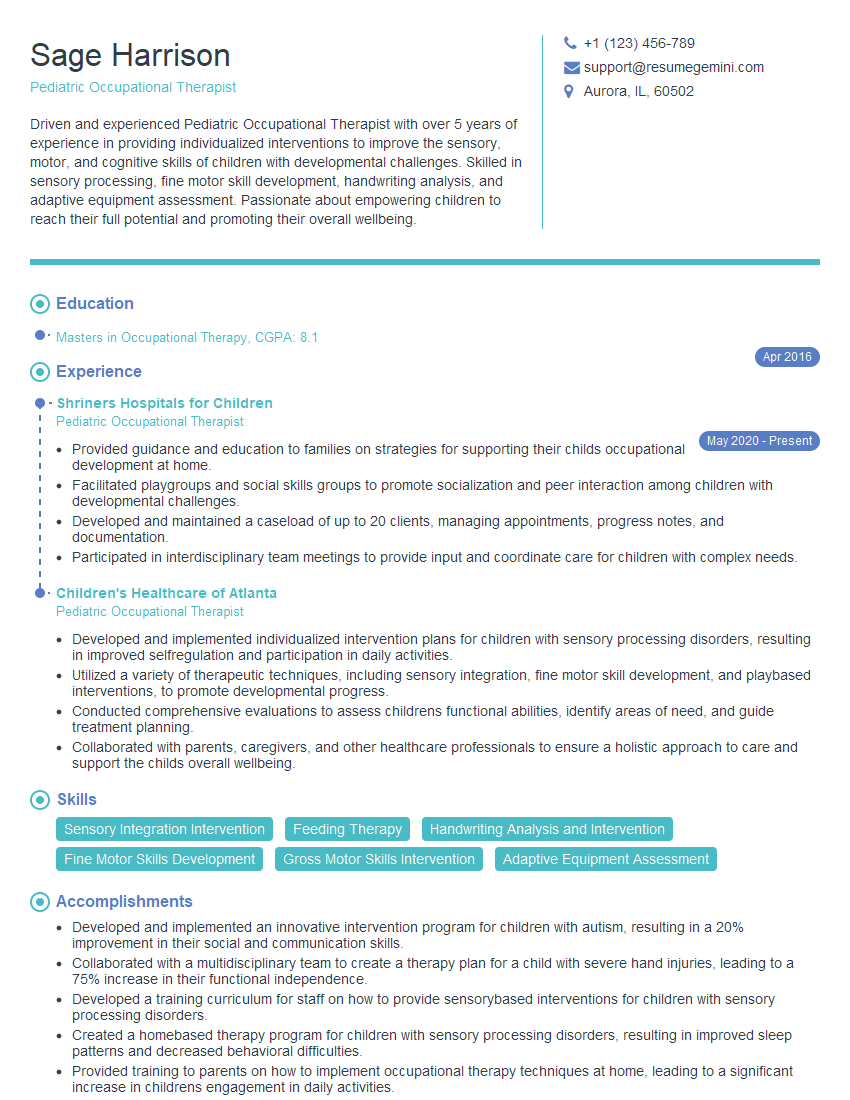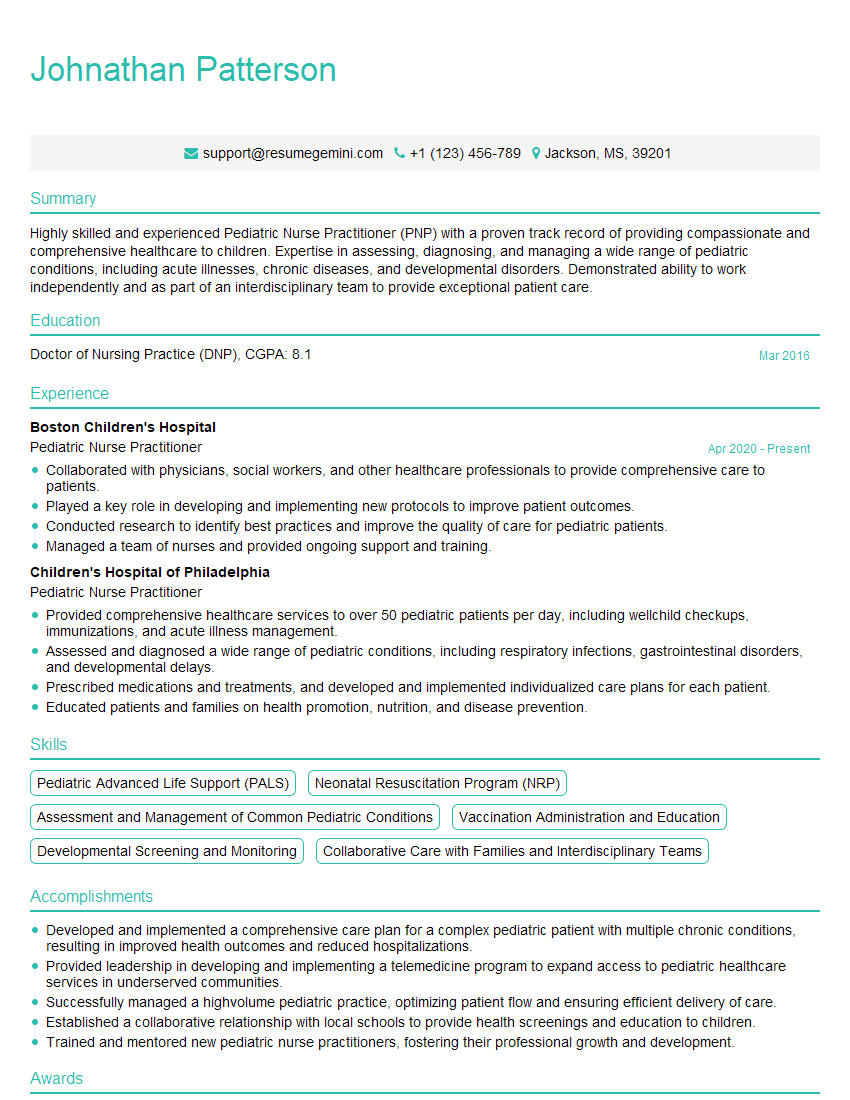Cracking a skill-specific interview, like one for Pediatric Medicine, requires understanding the nuances of the role. In this blog, we present the questions you’re most likely to encounter, along with insights into how to answer them effectively. Let’s ensure you’re ready to make a strong impression.
Questions Asked in Pediatric Medicine Interview
Q 1. Describe your approach to diagnosing childhood asthma.
Diagnosing childhood asthma involves a multi-faceted approach combining a thorough history, physical examination, and objective testing. It’s crucial to remember that asthma is a clinical diagnosis, meaning we rely heavily on the patient’s symptoms and response to treatment.
History: I start by carefully documenting the child’s symptoms, including the frequency, duration, and severity of wheezing, coughing, shortness of breath, and chest tightness. I inquire about family history of asthma, allergies, and eczema (atopic triad), as genetic predisposition and allergic sensitization significantly increase the risk. Exposure to environmental triggers like smoke, pet dander, and pollen is also meticulously explored.
Physical Examination: This focuses on assessing respiratory effort, listening for wheezes and other abnormal breath sounds using a stethoscope, and observing for signs of respiratory distress, such as nasal flaring, retractions, and increased respiratory rate.
Objective Testing: Spirometry, although challenging in young children, plays a vital role in confirming the diagnosis and monitoring disease severity. Peak expiratory flow (PEF) monitoring can be used to assess lung function at home, empowering the child and their family to participate actively in their care. Other tests like allergy skin prick testing or blood tests (specific IgE) might be considered to identify potential triggers.
Diagnosis: A diagnosis of asthma is made when a child exhibits recurrent wheezing or other characteristic symptoms, in conjunction with demonstrable airway limitation (often shown via spirometry or PEF) and a positive response to bronchodilator therapy. It’s crucial to rule out other potential causes of similar symptoms, such as infections.
Example: A 7-year-old presents with recurrent nighttime cough and wheezing, particularly after playing sports. He has a family history of asthma and atopic dermatitis. His PEF is initially low but improves significantly after using a bronchodilator. This clinical presentation, along with positive response to treatment, strongly suggests asthma.
Q 2. Explain the management of febrile seizures in children.
Febrile seizures are convulsions that occur in children with a fever, usually between 6 months and 5 years of age. Management focuses on supportive care during the seizure and preventing future occurrences. It’s crucial to differentiate between febrile seizures and other causes of seizures.
During the Seizure: The primary goal is to ensure the child’s safety. This involves protecting the child from injury by gently positioning them on their side to prevent aspiration, removing any nearby objects that could cause harm, and timing the seizure. Do not attempt to restrain the child.
After the Seizure: Once the seizure has ended, monitoring the child’s vital signs (temperature, heart rate, respiratory rate) is crucial. The child will likely be drowsy and confused; allowing them to rest is important. If the seizure lasted longer than 5 minutes, or if the child had multiple seizures, immediate medical attention is necessary.
Prevention of Future Seizures: While most children with febrile seizures do not experience long-term neurological consequences, strategies to reduce the risk of recurrence include prompt treatment of fevers (with antipyretics like acetaminophen or ibuprofen), and ensuring adequate hydration.
Important Note: The possibility of an underlying neurological condition must be investigated if the seizure was prolonged, atypical, or if there are other neurological symptoms. A thorough neurological evaluation might be warranted.
Example: A 2-year-old child presents with a high fever and a generalized seizure lasting 2 minutes. After the seizure, the child is drowsy but responsive. Treatment would focus on managing the fever and reassuring the parents. A neurological examination would be performed to rule out any underlying cause.
Q 3. What are the common causes of pediatric diarrhea, and how do you differentiate them?
Pediatric diarrhea is a common presentation with several potential causes, often requiring careful differentiation to guide appropriate treatment. Common causes include viral, bacterial, and parasitic infections, as well as dietary intolerances or antibiotic use.
Viral Gastroenteritis: This is the most common cause, usually self-limiting and characterized by watery diarrhea, vomiting, and mild fever. Rotavirus and norovirus are frequent culprits.
Bacterial Gastroenteritis: Bacterial infections can range in severity, from mild to life-threatening. Salmonella, Campylobacter, and E. coli are examples; they may present with bloody diarrhea, fever, and abdominal cramps.
Parasitic Infections: Giardiasis and cryptosporidiosis are common parasitic infections causing diarrhea, often lasting for weeks and potentially leading to dehydration.
Dietary Intolerances: Lactose intolerance, cow’s milk protein allergy, or celiac disease can trigger diarrhea, often accompanied by other gastrointestinal symptoms.
Antibiotic-Associated Diarrhea: Antibiotic use disrupts the normal gut flora, potentially leading to Clostridium difficile infection, causing severe diarrhea and colitis.
Differentiation: Distinguishing among causes often requires a detailed history, focusing on the nature of the diarrhea (watery, bloody, mucus), associated symptoms (fever, vomiting, abdominal pain), recent travel history, dietary changes, and antibiotic use. Stool examination for pathogens (bacteria, parasites) and other investigations might be necessary in specific cases.
Example: A child presents with sudden onset of watery diarrhea and vomiting after attending a picnic. This points toward a viral gastroenteritis, most likely. Contrastingly, a child with bloody diarrhea, high fever, and abdominal cramps might be suspected to have a bacterial infection requiring further investigation.
Q 4. How would you assess and manage a child with suspected pneumonia?
Suspected pneumonia in children necessitates a thorough assessment to determine the severity and guide appropriate management. It’s crucial to quickly recognize signs of respiratory distress.
Assessment: I begin with a detailed history focusing on respiratory symptoms (cough, shortness of breath, wheezing), fever, and any other systemic symptoms like lethargy or poor feeding. A physical examination includes auscultation of the lungs for crackles, wheezes, or diminished breath sounds, along with assessment of respiratory rate, heart rate, oxygen saturation, and overall clinical appearance.
Investigations: Chest X-ray is crucial for confirming the diagnosis and identifying the extent of lung involvement. Blood tests may be ordered to assess for infection (complete blood count, inflammatory markers). In some cases, further investigations might be necessary to identify the causative organism (blood cultures, sputum cultures).
Management: Management depends on the severity of the pneumonia. Mild cases might be managed at home with supportive care, including adequate hydration and rest. Antibiotics are indicated for bacterial pneumonia. In severe cases (respiratory distress, hypoxemia), hospitalization may be required for intravenous antibiotics, supplemental oxygen, and close monitoring.
Example: A 3-year-old presents with fever, cough, and increased work of breathing. Chest X-ray shows consolidation in the right lower lobe, confirming pneumonia. The child is hospitalized, started on intravenous antibiotics, and receives supplemental oxygen.
Q 5. Outline your approach to evaluating a child with developmental delays.
Evaluating a child with developmental delays requires a comprehensive, multidisciplinary approach to identify the underlying cause and plan appropriate interventions.
History: A detailed developmental history is crucial, including milestones achieved and areas of concern (gross motor, fine motor, language, cognitive, social-emotional). Family history of developmental delays or genetic conditions is also important.
Physical Examination: A thorough physical examination assesses the child’s overall health, looking for any physical anomalies or neurological findings that could contribute to developmental delays.
Developmental Assessment: Standardized developmental screening tools like the Ages and Stages Questionnaires (ASQ) or Bayley Scales of Infant and Toddler Development are used to objectively assess the child’s developmental level in various domains.
Further Investigations: Based on the initial assessment, further investigations may be necessary, including hearing and vision screening, genetic testing, neuroimaging (MRI, CT scan), or metabolic studies.
Multidisciplinary Team Approach: A collaborative approach involving pediatricians, developmental pediatricians, therapists (occupational, physical, speech), and other specialists is often necessary to develop an individualized intervention plan.
Example: A 2-year-old child is referred for evaluation due to concerns about delayed language development. The ASQ reveals significant delays in language and communication skills. Further investigations are conducted to rule out underlying hearing impairment, and the child is enrolled in early intervention programs for speech therapy.
Q 6. Describe the diagnostic criteria and management of attention-deficit/hyperactivity disorder (ADHD).
Attention-Deficit/Hyperactivity Disorder (ADHD) is a neurodevelopmental disorder characterized by inattention, hyperactivity, and impulsivity. Diagnosis relies on a combination of clinical evaluation and standardized assessments.
Diagnostic Criteria: The Diagnostic and Statistical Manual of Mental Disorders (DSM-5) outlines specific criteria for ADHD, requiring symptoms to be present in at least two settings (e.g., school and home) and interfere significantly with daily functioning. Symptoms must be present before age 12 and persist for at least six months.
Assessment: A thorough clinical interview with the child and parents is essential to gather information about symptom presentation, developmental history, and impact on daily life. Standardized rating scales, such as the Conners’ Rating Scales or ADHD Rating Scale-IV, are used to quantify the severity of symptoms.
Management: Management of ADHD is often multi-modal and individualized, often including behavioral therapy, medication, and educational interventions.
Behavioral Therapy: Parent training, classroom management strategies, and behavioral interventions aim to improve the child’s self-regulation and coping skills.
Medication: Stimulant medications (methylphenidate, amphetamine) are often the first-line treatment for ADHD, improving attention, focus, and reducing hyperactivity. Non-stimulant medications are available for those who don’t respond well to stimulants or have contraindications.
Educational Interventions: Collaboration with schools is essential to develop an individualized education program (IEP) that addresses the child’s specific learning needs and challenges.
Example: A child demonstrates persistent inattention, impulsivity, and hyperactivity both at home and school, significantly affecting his academic performance and social interactions. After a thorough evaluation, he is diagnosed with ADHD and starts treatment with stimulant medication combined with behavioral therapy and an IEP at school.
Q 7. Explain the common causes and treatment of childhood obesity.
Childhood obesity is a complex problem with multiple contributing factors. Management requires a multifaceted approach addressing lifestyle modifications, behavioral interventions, and in some cases, medical interventions.
Common Causes: Childhood obesity arises from an imbalance between energy intake and expenditure. Factors influencing this include:
- Dietary Habits: Consumption of high-calorie, nutrient-poor foods, excessive sugary drinks, and large portion sizes.
- Physical Inactivity: Sedentary lifestyles, limited opportunities for physical activity, and excessive screen time.
- Genetic Predisposition: Genetic factors influence metabolism, appetite regulation, and body composition.
- Socioeconomic Factors: Access to healthy foods, safe environments for physical activity, and parental support all play a role.
- Medical Conditions: Certain medical conditions can contribute to weight gain.
Treatment: Management strategies involve lifestyle changes focused on:
- Dietary Modification: Reducing consumption of sugary drinks and unhealthy foods, increasing intake of fruits, vegetables, and whole grains.
- Increased Physical Activity: Promoting at least 60 minutes of moderate-to-vigorous physical activity daily.
- Behavioral Interventions: Teaching healthy eating habits, managing portion sizes, and reducing screen time.
- Family Involvement: Involving the entire family in making lifestyle changes.
Medical Interventions: In some cases, medical interventions such as medication to manage appetite or underlying medical conditions may be necessary.
Example: A 10-year-old child with obesity is enrolled in a weight management program that includes dietary counseling, increased physical activity, family-based behavioral therapy, and regular monitoring of weight and health parameters.
Q 8. How would you counsel parents about childhood vaccinations?
Counseling parents about childhood vaccinations involves a multifaceted approach focusing on education, addressing concerns, and building trust. I begin by emphasizing the crucial role vaccines play in protecting children from preventable diseases, explaining how they work to stimulate the immune system and create long-lasting immunity. I present the benefits of each vaccine in clear, simple language, avoiding medical jargon. For example, I might explain that the MMR vaccine protects against measles, mumps, and rubella, three serious illnesses that can have devastating consequences.
I then address common parental concerns, such as vaccine safety and side effects. I assure them that vaccines undergo rigorous testing and that side effects, while possible, are usually mild and temporary. I provide evidence-based information from reputable sources like the CDC and AAP, and I encourage them to ask questions. Sometimes, parents worry about vaccine overload; I explain that the timing of vaccines is carefully planned to minimize the risk of adverse reactions and maximize immune response.
Finally, I emphasize the importance of informed decision-making and shared decision-making. I empower parents by providing them with the information they need to make the best choices for their child’s health. I follow up after each vaccination appointment to address any questions or concerns they may have.
Q 9. What are the signs and symptoms of child abuse, and what is your role in reporting suspected cases?
Recognizing child abuse is critical. Signs can be physical, like unexplained bruises, burns, or fractures; behavioral, such as sudden changes in behavior, fear of adults, or withdrawal; or neglect, such as poor hygiene, malnutrition, or lack of appropriate medical care. The presentation can vary widely depending on the type and duration of abuse.
My role is to carefully assess any child presenting with concerning signs or symptoms. If I suspect abuse, I must follow mandated reporting guidelines. This involves documenting my observations meticulously, including the child’s history, physical examination findings, and any statements made by the child or caregivers. I then report my suspicions to the appropriate child protective services agency. This is a legal and ethical obligation, as failing to report suspected abuse can have serious consequences for the child. The exact procedures vary by location, but the priority remains the child’s safety and well-being.
For example, if a child presents with multiple bruises in different stages of healing and an inconsistent explanation from the caregiver, I would escalate my concerns. My documentation would include the details of the bruising, the caregiver’s explanation, and any statements made by the child. I would then initiate the reporting process to protect the child.
Q 10. Discuss the ethical considerations in pediatric medicine.
Ethical considerations in pediatric medicine are paramount, centered around the best interests of the child. This involves respecting the child’s autonomy as they mature, balancing the child’s wishes with parental authority, maintaining confidentiality (with appropriate exceptions), and ensuring equitable access to care, regardless of socioeconomic status or insurance coverage.
One crucial ethical dilemma arises when parental decisions conflict with what a physician believes is in the best interests of the child. For instance, parents might refuse a life-saving blood transfusion for religious reasons. In such scenarios, the physician has an obligation to advocate for the child’s welfare while respecting parental rights. This may involve exploring alternative solutions, engaging in respectful dialogue, and, if necessary, seeking legal intervention.
Another ethical challenge relates to informed consent. For minors, the process often involves obtaining consent from parents or guardians, while considering the child’s wishes as they develop. A nuanced approach is needed to ensure the child’s voice is heard appropriately while recognizing the limitations of their understanding at different developmental stages.
Furthermore, issues of resource allocation and equitable access to healthcare create ethical dilemmas. Physicians must advocate for policies and practices that ensure all children have equal opportunities for quality healthcare regardless of their background or ability to pay.
Q 11. How do you manage a child with acute appendicitis?
Managing acute appendicitis in a child requires a prompt and decisive approach. The diagnosis is primarily clinical, based on a detailed history and physical examination. Key symptoms include right lower quadrant abdominal pain (often starting periumbilically and migrating), nausea, vomiting, fever, and anorexia. Physical exam findings might reveal tenderness to palpation in the right lower quadrant (McBurney’s point), guarding, and rebound tenderness.
Laboratory tests, such as a complete blood count (CBC), may reveal leukocytosis (elevated white blood cell count). Imaging studies like an ultrasound or CT scan can confirm the diagnosis and rule out other conditions, although clinical judgment often plays the most crucial role. Early diagnosis is vital because a ruptured appendix can lead to serious complications such as peritonitis.
Treatment involves surgical appendectomy – removal of the appendix – as soon as possible. Preoperative management includes intravenous fluids for hydration, antibiotics to combat infection, and pain management. Postoperative care focuses on monitoring for signs of infection, providing pain relief, and ensuring adequate nutrition.
Q 12. Describe your approach to treating a child with a fractured femur.
Managing a child with a fractured femur involves a multi-step process prioritizing pain control, fracture reduction, and immobilization. The approach depends on the type and severity of the fracture.
Initial management focuses on pain relief using analgesics and splinting the injured limb to prevent further damage. A thorough physical exam and imaging (X-rays) are essential to characterize the fracture. Treatment options may include closed reduction (manipulating the bone fragments into alignment without surgery) or open reduction and internal fixation (ORIF) – surgery to realign and stabilize the fracture using plates, screws, or rods. The choice depends on the fracture pattern, the child’s age and overall health, and the expertise available.
Post-operative care includes monitoring for complications such as infection, compartment syndrome (a serious condition where pressure builds up in the muscles), and delayed union (slow healing). Physical therapy is crucial for regaining mobility and preventing long-term disability. The length of recovery depends on the fracture type, the child’s age, and the effectiveness of treatment. Regular follow-up appointments are essential to monitor healing and progress.
Q 13. Explain the different types of childhood leukemia and their treatment.
Childhood leukemia encompasses various types, primarily classified as acute lymphoblastic leukemia (ALL) and acute myeloid leukemia (AML). ALL is the most common childhood cancer, affecting white blood cells (lymphocytes). AML affects a different type of white blood cell (myeloblasts). Both are characterized by uncontrolled production of abnormal white blood cells that crowd out normal blood cells, leading to anemia, infections, and bleeding problems.
Treatment involves a multi-modal approach, including chemotherapy, targeted therapy, and in some cases, bone marrow transplantation. The intensity and duration of treatment depend on factors like the specific type and subtype of leukemia, the child’s age and overall health, and the stage of the disease. Chemotherapy is often administered in phases, with the initial phase aimed at achieving remission (eliminating detectable leukemia cells). Maintenance therapy follows to prevent relapse. Targeted therapies may be used to enhance the effectiveness of chemotherapy or target specific leukemia cells.
Bone marrow transplantation, also known as stem cell transplantation, may be necessary in high-risk cases. This involves replacing the diseased bone marrow with healthy cells from a donor. Close monitoring, supportive care, and ongoing follow-up are vital throughout treatment to manage side effects and assess long-term outcomes. Treatment protocols are carefully tailored to each child’s individual needs.
Q 14. How do you assess and manage a child with dehydration?
Assessing and managing dehydration in a child requires a careful evaluation of symptoms and prompt intervention. Dehydration is a significant threat, particularly in young children, as their fluid reserves are relatively smaller. Symptoms vary depending on the severity, ranging from mild (slightly dry mouth, decreased urine output) to severe (sunken eyes, lethargy, rapid heart rate, and decreased skin turgor).
Assessment involves carefully observing the child’s overall condition, measuring vital signs (heart rate, blood pressure, temperature), assessing skin turgor (checking the skin’s elasticity), and assessing urine output. Laboratory tests may be necessary in severe cases to determine the electrolyte balance. Mild dehydration can often be managed with oral rehydration solutions (ORS), which contain balanced amounts of electrolytes and glucose. ORS is effective because it promotes efficient fluid absorption in the intestines.
For moderate to severe dehydration, intravenous fluids are necessary to quickly restore fluid balance and electrolyte levels. The type and rate of fluid administration depend on the severity and the child’s specific needs, often guided by laboratory results. Continuous monitoring is essential, and prompt medical attention is crucial to prevent life-threatening complications.
Q 15. Describe the common causes and management of neonatal jaundice.
Neonatal jaundice, or hyperbilirubinemia, is a yellowish discoloration of the skin and whites of the eyes in newborns, caused by a buildup of bilirubin in the blood. This bilirubin is a byproduct of the breakdown of red blood cells. Most cases are benign and resolve spontaneously, but some require intervention.
Common Causes:
- Physiologic Jaundice: The most common type, occurring in full-term infants after the first 24 hours of life due to the immature liver’s inability to process bilirubin efficiently. It usually resolves within 1-2 weeks.
- Breastfeeding Jaundice: Can occur due to insufficient breastfeeding leading to dehydration and decreased bilirubin excretion, or less commonly, due to certain components in breast milk inhibiting bilirubin conjugation.
- Breast Milk Jaundice: A less common type where substances in breast milk interfere with bilirubin processing, typically presenting after the first week of life and lasting longer than physiologic jaundice.
- Pathologic Jaundice: Appears within the first 24 hours of life or persists beyond 2 weeks, often indicating an underlying condition such as blood group incompatibility (e.g., Rh or ABO incompatibility), infections (e.g., sepsis), metabolic disorders, or liver disease.
Management: Management depends on the cause and severity of jaundice, assessed by measuring bilirubin levels (typically using transcutaneous bilirubinometry or serum bilirubin tests).
- Physiologic Jaundice: Usually requires close monitoring and frequent feeding to ensure adequate hydration and bilirubin excretion. Phototherapy (exposure to blue light) may be used if bilirubin levels are elevated.
- Breastfeeding Jaundice: Often managed by ensuring frequent, effective breastfeeding. Supplementation may be recommended in cases of poor weight gain.
- Breast Milk Jaundice: Usually managed by continued breastfeeding; temporary cessation is rarely needed.
- Pathologic Jaundice: Requires prompt investigation to identify and treat the underlying cause. This might involve blood tests, imaging studies, and specific treatments based on the diagnosis, such as exchange transfusions in severe cases.
Example: A newborn presents with jaundice on day 3 of life. Their bilirubin level is mildly elevated, and they are feeding well. This is likely physiologic jaundice, requiring close monitoring and frequent feedings. However, a baby with jaundice present at birth and severely elevated bilirubin levels needs immediate investigation for a possible underlying condition like hemolysis.
Career Expert Tips:
- Ace those interviews! Prepare effectively by reviewing the Top 50 Most Common Interview Questions on ResumeGemini.
- Navigate your job search with confidence! Explore a wide range of Career Tips on ResumeGemini. Learn about common challenges and recommendations to overcome them.
- Craft the perfect resume! Master the Art of Resume Writing with ResumeGemini’s guide. Showcase your unique qualifications and achievements effectively.
- Don’t miss out on holiday savings! Build your dream resume with ResumeGemini’s ATS optimized templates.
Q 16. What are the risk factors for sudden infant death syndrome (SIDS)?
Sudden Infant Death Syndrome (SIDS) is the sudden, unexpected death of an infant under one year of age that remains unexplained after a thorough investigation. While the exact cause remains unknown, several risk factors have been identified.
- Prone Sleeping: Placing an infant to sleep on their stomach significantly increases the risk of SIDS. Supine (back) sleeping is recommended.
- Soft Bedding: Soft bedding, loose blankets, pillows, bumpers, and toys in the crib can increase the risk of suffocation or rebreathing of exhaled carbon dioxide.
- Overheating: Overdressing the infant or using excessive bedding can lead to overheating, which is a risk factor for SIDS.
- Prematurity or Low Birth Weight: Premature infants and those with low birth weight are at increased risk.
- Exposure to Smoke: Maternal smoking during pregnancy and exposure to secondhand smoke after birth increase the risk.
- Unsafe Sleep Surfaces: Sleeping on soft surfaces like adult beds, sofas, or armchairs significantly raises the risk.
- Co-Sleeping: While some families practice safe co-sleeping, it is generally recommended that infants sleep in a separate crib in the parents’ room for the first year to reduce the risk of SIDS.
- Lack of Prenatal Care: Inadequate prenatal care can contribute to increased risk factors.
It’s crucial to remember that these are risk factors, not definite causes. Many infants with some of these risk factors do not die from SIDS. The combination of these factors increases the risk. Education and safe sleep practices are vital in SIDS prevention.
Q 17. How do you counsel families about end-of-life care for a terminally ill child?
Counseling families about end-of-life care for a terminally ill child is one of the most challenging aspects of pediatric medicine. It requires empathy, sensitivity, and a holistic approach.
My approach involves:
- Open Communication: Establishing open and honest communication with the family, acknowledging their grief and validating their feelings.
- Honest Assessment: Providing a realistic and honest prognosis while acknowledging the uncertainty inherent in predicting the course of a terminal illness.
- Individualized Plan: Collaborating with the family to develop an individualized plan of care that addresses their emotional, spiritual, and physical needs. This includes discussions about pain and symptom management, wishes for resuscitation or life support, and the child’s comfort.
- Palliative Care: Emphasizing the importance of palliative care, which focuses on providing comfort and improving the quality of life for the child and their family, even at the end of life. Palliative care includes pain management, symptom control, emotional support, and spiritual guidance.
- Practical Support: Offering practical support and guidance concerning financial assistance, resources, bereavement support groups, and making arrangements for the child’s care and funeral.
- Sibling Support: Including siblings in the process when appropriate and helping them cope with the loss and changes within the family.
- Follow Up: Providing ongoing support and follow-up care for the family after the child’s death.
Example: When explaining a poor prognosis to a family, I avoid medical jargon and use simple, direct language. I acknowledge their emotions, offer my condolences, and explain what the next steps will be, including palliative care options and how we’ll manage symptoms. The goal is to empower the family to make informed decisions and to ensure that the child’s remaining time is as comfortable and meaningful as possible.
Q 18. Explain your understanding of the principles of growth and development in children.
Understanding the principles of growth and development in children is fundamental to pediatric practice. It’s not just about measuring height and weight; it’s about recognizing the predictable yet variable patterns of physical, cognitive, social, and emotional changes that occur throughout childhood and adolescence.
Key principles include:
- Cephalocaudal Development: Development proceeds from head to toe, with the head and upper body developing before the lower body.
- Proximodistal Development: Development proceeds from the center of the body outward, with the trunk and limbs developing before the hands and feet.
- Differentiation: Simple movements and actions develop into more complex and refined skills.
- Hierarchical Integration: Development involves the integration of simpler skills into more complex ones.
- Predictable Sequences: While the timing may vary, the sequence of developmental milestones is usually consistent.
- Individual Variation: There’s significant variation in the rate of development among children. A child may be ahead or behind in certain areas without necessarily indicating a problem.
Practical Application: Understanding these principles helps pediatricians assess a child’s development appropriately, identify potential developmental delays or problems, and provide tailored guidance and interventions. For example, a pediatrician uses developmental screenings to identify children who might need early intervention services, such as speech therapy or occupational therapy. We also use growth charts to assess whether a child’s growth is within the expected range and to identify any potential nutritional problems.
Q 19. How do you manage a child with a severe allergic reaction?
Managing a child with a severe allergic reaction, or anaphylaxis, is a life-threatening emergency requiring immediate action. Anaphylaxis is a rapid, severe, and potentially fatal allergic reaction that involves multiple organ systems.
Management:
- Assess the airway, breathing, and circulation (ABCs): This is the first priority. If the child is unconscious, unresponsive or having difficulty breathing, immediately call emergency medical services (EMS).
- Administer epinephrine (adrenaline): This is the cornerstone of anaphylaxis treatment. If the child has a prescribed epinephrine auto-injector (EpiPen or similar), administer it immediately according to the instructions, even if symptoms are improving. Repeat the dose every 5-15 minutes as needed.
- Maintain the airway: If the child is having difficulty breathing, consider using adjunctive measures such as oxygen therapy or positioning to help them breathe better. In severe cases, advanced airway management may be required by paramedics.
- Transport to the hospital: Even after epinephrine administration and apparent improvement, transport to the hospital is crucial for ongoing monitoring and treatment. Anaphylaxis can recur.
- Further Management in Hospital: Hospital care may include intravenous fluids, antihistamines, corticosteroids, and monitoring for ongoing complications such as respiratory distress or cardiovascular instability.
Example: A child presents with hives, swelling of the face and throat, difficulty breathing, and hypotension after eating peanuts. Immediate administration of epinephrine, oxygen, and calling 911 are critical first steps. Ongoing monitoring in the hospital is essential to prevent recurrence and to manage potential complications.
Q 20. Describe your experience with performing pediatric physical examinations.
Performing pediatric physical examinations requires a unique approach, incorporating age-appropriate techniques and considerations. My experience spans years of practice, encompassing routine well-child visits to the assessment of acutely ill infants and children.
Key Aspects of My Approach:
- Establishing rapport: Building trust with the child and their parents is paramount. This involves using age-appropriate language, toys, and a gentle, reassuring manner.
- Systematic approach: A systematic examination is crucial, covering general appearance, vital signs, skin, head, neck, chest, abdomen, and extremities. The examination needs to be adapted to the age and developmental stage of the child.
- Developmental assessment: Integrating developmental assessment with the physical exam, observing the child’s motor skills, language development, social interaction, and overall behavior.
- Age-appropriate techniques: Employing appropriate techniques for each age group. For example, examination of an infant differs significantly from that of a teenager.
- Communication: Effective communication with both the child and the parents is crucial to elicit relevant information and provide reassurance.
- Documentation: Meticulous documentation of all findings is critical, including vital signs, physical examination results, and any relevant observations.
Example: When examining a toddler, I might begin by engaging them with a toy to establish rapport before proceeding with the physical examination. I would adapt the examination sequence to their cooperation, perhaps examining their heart and lungs while they are distracted by the toy before attempting to assess their ears and throat.
Q 21. What is your approach to managing a child with type 1 diabetes?
Managing a child with type 1 diabetes is a complex, long-term process requiring a multidisciplinary approach. Type 1 diabetes is an autoimmune disease where the body’s immune system attacks the insulin-producing cells in the pancreas, leading to a deficiency of insulin.
My approach involves:
- Diagnosis and Confirmation: Establishing the diagnosis through blood tests (fasting glucose, HbA1c, C-peptide), confirming the diagnosis of type 1 diabetes, and explaining the disease process to the child and their family.
- Insulin Therapy: Prescribing appropriate insulin therapy, usually multiple daily injections or an insulin pump. The choice depends on factors such as the child’s age, lifestyle, and preferences.
- Blood Glucose Monitoring: Teaching the child and their family how to monitor blood glucose levels regularly and how to interpret the results.
- Nutrition Education: Providing comprehensive nutrition education to help the child and their family plan healthy meals and snacks, managing carbohydrate intake appropriately. This includes working with registered dietitians.
- Exercise Recommendations: Encouraging regular physical activity while teaching the child and family how to adjust insulin doses accordingly.
- Education and Support: Providing ongoing education and support to the child and family about diabetes management, including managing hypoglycemia and hyperglycemia, sick day management, and recognizing warning signs of complications.
- Regular Follow-up: Scheduling regular follow-up appointments to monitor blood glucose levels, HbA1c, and to address any concerns or challenges.
- Collaboration with Specialists: Working collaboratively with other specialists, such as endocrinologists and ophthalmologists, to ensure comprehensive management and to screen for potential complications.
Example: A newly diagnosed 8-year-old with type 1 diabetes would require education on insulin administration, blood glucose monitoring, carbohydrate counting, and recognizing hypoglycemic symptoms. The family will need support in integrating these new routines into their daily lives, and ongoing adjustments will be necessary as the child grows and their needs change.
Q 22. How do you address parental concerns about childhood vaccinations?
Addressing parental concerns about childhood vaccinations requires a compassionate, evidence-based approach. I begin by acknowledging their anxieties, validating their feelings, and actively listening to their specific concerns. Many concerns stem from misinformation or fear of adverse effects. I then provide clear, concise information about the benefits of vaccines, drawing on reputable sources like the CDC and WHO. I explain how vaccines work to protect children from serious illnesses, and I discuss the extremely low risk of serious side effects compared to the much higher risk of contracting the diseases themselves. I often use visual aids like charts and graphs to illustrate the effectiveness of vaccines and the impact of vaccine-preventable diseases. If the parent expresses concern about a specific vaccine, I address their concerns directly with factual information and, if appropriate, refer them to additional resources or specialist consultations. Finally, I empower parents by making them active participants in the decision-making process, ensuring they feel heard and respected throughout the discussion. For example, if a parent is concerned about mercury in vaccines, I explain the difference between thimerosal (a mercury-containing preservative no longer used in most childhood vaccines) and methylmercury (the type of mercury found in fish that is harmful). This personalized approach fosters trust and helps parents make informed decisions.
Q 23. Explain your experience with using electronic health records (EHRs) in pediatrics.
Electronic Health Records (EHRs) are integral to my pediatric practice. I’m proficient in using various EHR systems to manage patient data, including medical history, immunization records, lab results, and progress notes. I use EHRs to track growth charts, schedule appointments, and generate reports. The ability to quickly access a patient’s complete medical record ensures continuity of care, even across different healthcare providers. For example, I can instantly review a child’s allergy history before administering medication or assess their previous growth patterns to identify potential developmental concerns. EHRs also facilitate efficient communication with other specialists, such as cardiologists or neurologists, through secure messaging and shared records. Furthermore, EHRs help in population health management by identifying trends and patterns in patient data, allowing for proactive interventions and improved public health initiatives. While EHRs offer significant benefits, I’m aware of the challenges, such as the time it takes for data entry and the potential for system errors. I prioritize efficient workflow and regularly participate in training to optimize my use of the system.
Q 24. Describe a challenging pediatric case and how you managed it.
One challenging case involved a 6-year-old girl presenting with recurrent abdominal pain and unexplained weight loss. Initial investigations, including blood tests and imaging, were unremarkable. The parents were increasingly distressed, and the child’s school performance was suffering. I systematically ruled out common causes like appendicitis, constipation, and infections. However, after careful consideration of her symptoms, her dietary habits, and family history, I suspected Celiac disease. I ordered specialized blood tests for Celiac antibodies, which came back positive. An endoscopy confirmed the diagnosis. Managing this case required patience, persistence, and a collaborative approach. I explained the diagnosis to the parents in simple terms, focusing on the long-term implications and the importance of dietary management. I also referred the family to a registered dietitian specializing in Celiac disease to develop a tailored dietary plan. The girl responded well to the gluten-free diet, her symptoms subsided, and her weight normalized. This case highlighted the importance of thorough history-taking, detailed investigation, and close collaboration with families in managing complex pediatric conditions.
Q 25. How do you communicate complex medical information to parents and children?
Communicating complex medical information requires adapting my approach to the age and understanding of both the child and the parent. With children, I use age-appropriate language, analogies, and visual aids like pictures or drawings. For example, explaining medication using a simple analogy like a ‘medicine superhero’ fighting off ‘germs’ can be effective. I always encourage questions and ensure the child understands the basic concepts before proceeding. When communicating with parents, I tailor my language to their level of medical knowledge. I avoid using technical jargon unless absolutely necessary, and when I do, I provide clear definitions. I present information in a structured manner, starting with the key findings and their implications, then going into more detail as needed. I actively involve the parents in the decision-making process, answering their questions thoroughly and addressing their concerns with empathy. Using written materials, such as pamphlets or summaries of the discussion, can reinforce understanding and provide a handy reference. Open and honest communication is key to building trust and fostering a positive therapeutic relationship.
Q 26. What is your approach to managing a child with behavioral problems?
My approach to managing a child with behavioral problems is multi-faceted and emphasizes a holistic understanding of the child’s environment and development. It begins with a thorough assessment of the child’s behavior, including its frequency, severity, and triggers. I consider the child’s age, developmental stage, and medical history, as well as their family dynamics and social environment. I explore potential contributing factors such as underlying medical conditions, learning disabilities, or trauma. Management often involves a combination of strategies, including behavioral modification techniques, parental counseling, and, if necessary, referral to specialists like psychologists or psychiatrists. For example, a child exhibiting disruptive classroom behavior may benefit from strategies such as positive reinforcement, clear expectations, and consistent discipline at home and school. In cases of more severe behavioral issues or suspected underlying mental health conditions, medication may be considered in consultation with a psychiatrist. The goal is to develop a tailored treatment plan that addresses the specific needs of the child and their family, promoting their overall well-being and improving their quality of life.
Q 27. Describe your understanding of child psychology and its importance in pediatric care.
Understanding child psychology is crucial in providing comprehensive pediatric care. A child’s emotional, social, and cognitive development significantly impacts their physical health and well-being. I integrate knowledge of child development milestones into my assessments, recognizing that a child’s behavior and responses can be influenced by their stage of development. For example, a toddler’s tantrums are very different from the anxiety of a teenager. Understanding common developmental challenges, such as separation anxiety or difficulties with peer interactions, allows me to tailor my approach to address these issues effectively. I utilize principles of developmental psychology to guide my communication with children, building rapport and making them feel comfortable sharing their concerns. I’m also aware of the significant impact of parental and family dynamics on a child’s mental health. Therefore, I often involve parents in the treatment process, providing guidance and support on effective parenting techniques. A strong foundation in child psychology enhances my ability to recognize potential mental health problems early on and provide timely intervention, promoting the child’s overall health and happiness.
Q 28. How do you stay updated with the latest advancements in pediatric medicine?
Staying updated with the latest advancements in pediatric medicine is a continuous process. I regularly attend professional conferences and workshops, such as those organized by the American Academy of Pediatrics (AAP). I actively participate in continuing medical education (CME) programs to maintain my board certification and enhance my knowledge of new treatments, diagnostic techniques, and guidelines. I subscribe to reputable pediatric journals and regularly review relevant research publications. I also maintain memberships in professional organizations, such as the AAP, which provide access to up-to-date information and resources. Furthermore, I actively engage in peer-to-peer learning through discussions with colleagues and participation in case conferences. This multifaceted approach ensures that my clinical practice reflects the most current evidence-based approaches, leading to optimal patient care. I believe lifelong learning is fundamental in this dynamic field.
Key Topics to Learn for Pediatric Medicine Interview
- Neonatal Care: Understanding physiological differences in newborns, common neonatal conditions (e.g., jaundice, respiratory distress syndrome), and appropriate interventions.
- Infant and Child Development: Knowledge of developmental milestones, recognizing developmental delays, and addressing developmental concerns in a clinical setting.
- Common Childhood Illnesses: Diagnosis and management of infections (e.g., otitis media, pneumonia, influenza), and other prevalent childhood conditions (e.g., asthma, allergies).
- Pediatric Pharmacology: Understanding age-appropriate medication dosing, pharmacokinetic differences in children, and potential side effects.
- Ethical Considerations in Pediatrics: Navigating complex ethical dilemmas, such as informed consent in minors, end-of-life care, and parental decision-making.
- Pediatric Emergency Medicine: Recognizing and responding to pediatric emergencies (e.g., trauma, seizures, respiratory failure), and applying appropriate life-saving measures.
- Chronic Disease Management in Children: Developing and implementing long-term management plans for conditions like diabetes, cystic fibrosis, and congenital heart disease. This includes understanding patient and family education needs.
- Communication and Patient Interaction: Effective communication strategies for interacting with children and their families, building rapport, and delivering sensitive information.
- Problem-Solving in Pediatric Cases: Developing a systematic approach to diagnosing and managing pediatric cases, utilizing diagnostic tools and clinical reasoning skills.
Next Steps
Mastering these key areas in Pediatric Medicine is crucial for career advancement and securing your dream position. A strong foundation in these topics will significantly improve your interview performance and showcase your expertise. To enhance your job prospects, it’s essential to create an ATS-friendly resume that effectively highlights your skills and experience. We highly recommend utilizing ResumeGemini, a trusted resource for building professional resumes. ResumeGemini provides examples of resumes tailored to Pediatric Medicine, helping you present yourself in the best possible light to prospective employers. Take the next step towards your successful career in Pediatric Medicine – build a compelling resume today!
Explore more articles
Users Rating of Our Blogs
Share Your Experience
We value your feedback! Please rate our content and share your thoughts (optional).
What Readers Say About Our Blog
Interesting Article, I liked the depth of knowledge you’ve shared.
Helpful, thanks for sharing.
Hi, I represent a social media marketing agency and liked your blog
Hi, I represent an SEO company that specialises in getting you AI citations and higher rankings on Google. I’d like to offer you a 100% free SEO audit for your website. Would you be interested?
